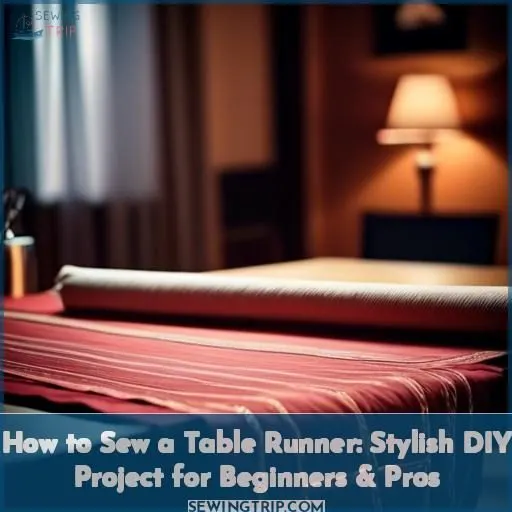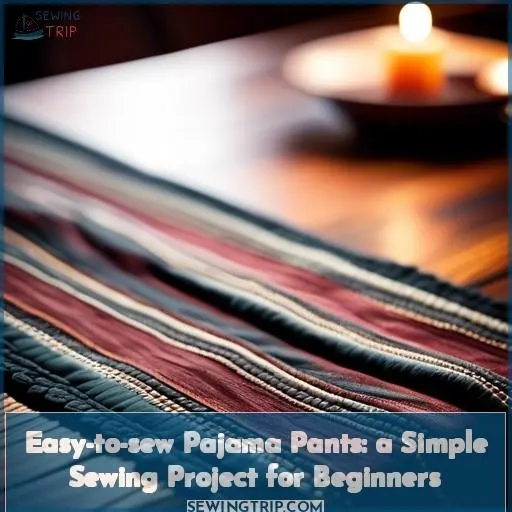This site is supported by our readers. We may earn a commission, at no cost to you, if you purchase through links.

To sew a table runner, you’ll need fabric, coordinating thread, scissors, pins, and a sewing machine.
First, cut two rectangular pieces of fabric for the top and bottom, and two long strips for the sides.
Pin the side strips to the top and bottom pieces, right sides together.
Sew along the edges using a 1/4 inch seam allowance.
Press the seams open, then turn the runner right side out.
Topstitch close to the edges for a crisp look.
You can also add decorative quilting details or embellishments to personalize your table runner.
If you’d like more guidance, the following steps will walk you through the process in greater detail.
Table Of Contents
Key Takeaways
- Select a thread color that closely matches your fabric to ensure that the stitches blend seamlessly into the table runner for a professional finish.
- Choose your fabric wisely, considering the exposure to light and potential fading, and opt for high-quality materials that complement your table decor.
- Employ quilting techniques such as hand quilting, domestic machine quilting, or long-arm quilting to add texture and intricacy to your table runner.
- When finishing the table runner, use a rotary cutter for precise cuts, secure thread ends with a surgeon’s knot, and attach a binding to the edges for a polished look.
How to Sew a Table Runner?
To sew a table runner, follow these steps:
- Measure the table or space where the runner will be placed to determine the appropriate size.
- Choose a fabric, such as cotton or linen, and cut it to the desired size, adding a 1-inch (2.5 cm) seam allowance to each measurement.
- Pin the fabric along the edges, leaving a gap of a few inches for turning.
- Sew the fabric together using a 1/2-inch (1.3 cm) seam allowance, leaving the gap open.
- Trim the corners to prevent bulk.
- Turn the fabric right-side out through the gap.
- Press the runner flat and topstitch along each long edge, 1/4-1/2 inch (0.64-1.3 cm) from the edges.
- Press the short edges 1 inch (2.5 cm) to the backing side and then 1 inch (2.5 cm) to the back side.
- Stitch along each folded edge, close to the inner fold.
For a more detailed guide, consider watching a video tutorial or reading a step-by-step tutorial on a sewing blog or website.
Thread: Select a Thread Color That Matches Your Fabric
When sewing a table runner, you’ll want to carefully select a thread color that closely matches your fabric choices. Choosing a complementary thread guarantees tidy, professional-looking stitches that blend seamlessly into the overall design.
Thread Selection
Choosing the right thread for your DIY table runner is like picking the perfect accessory for your outfit—it makes all the difference. Here’s how to nail it:
- Match thread colors closely to your fabric for a seamless look.
- Consider thread weight and type for durability and ease of sewing.
- Opt for high-quality thread to avoid breakage and frustration.
- Check thread availability to prevent your project from hitting a snag.
Fabric Choices
Regarding fabric selection for your table runner, you have a multitude of choices available to you. Employ remnants or leftover materials to minimize expenditures, or merge fabrics from diverse projects to conceive a distinctive aesthetic. Holiday-themed fabrics are optimal for seasonal runners, and opt for fabrics that harmonize with your table décor. Contemplate the exposure to light and potential fading when selecting your fabric, as certain materials may not withstand direct sunlight. For quilting, choose a uniform batting and backing for numerous runners to economize on materials. Inquire with your quilter regarding their preferences for shared materials, as they may have specific suggestions. Finishing techniques can amplify your runner’s design, so consider manual quilting, domestic machine quilting, or long arm quilting to impart texture and intricacy.
To craft a table runner, you’ll require fabric (20 inches exceeding your table length), thread, an iron and ironing board, starch, and a sewing machine. Adhere to these steps:
- Ascertain your table length and trim your fabric 20 inches longer.
- Fold and cut your fabric lengthwise into three equal thirds.
- Fold your fabric in half lengthwise, apply starch, and iron.
- Sew the sides opposite the fold together.
- Sew one end together, trim corners, and invert.
For additional DIY endeavors, consider constructing easy-to-sew pajama pants, a no-sew super voluminous tulle skirt, or 10 homemade gifts under $10.
Quilting Techniques
Quilting techniques can elevate your table runner to an eye-catching piece.
Consider simple finishing methods like hand quilting or domestic machine quilting for a personal touch.
Long arm quilting is a quicker, more inexpensive option.
When using shared materials like batting and backing fabric, ask your quilter for preferences.
By experimenting with these techniques, you can create custom sizes and patterns that showcase your creativity.
Easy-to-sew Pajama Pants: a Simple Sewing Project for Beginners
Ready to embark on a straightforward sewing endeavor? Let’s explore the creation of sleepwear pants! This is an ideal novice project that can be completed within an hour or two. Here are some straightforward guidelines:
- Choose your fabric: Opt for a soft, comfortable fabric like cotton or flannel. You can even utilize an existing pair of pajama pants as a reference for cutting the new fabric.
- Trace the pattern: Lay the old pajama pants on the fold of the new fabric and trace the pattern. Ensure you leave sufficient seam allowance and hem allowance.
- Cut the fabric: Carefully cut the fabric along the traced lines. You’ll require two pieces for each leg.
- Sew the legs: Sew the legs together along the traced lines, leaving the crotch area open.
- Create the elastic casing: Fold the raw edges of the legs inward and press them flat. Then, sew a seam along the folded edges to create the elastic casing.
- Insert the elastic: Cut a piece of elastic to the desired length and insert it into the casing. Adjust the elastic to fit comfortably around the waist.
- Sew the crotch: Sew the crotch area closed, ensuring you leave sufficient space for movement.
- Hem the legs: Fold the raw edges of the legs inward and press them flat. Then, sew a seam along the folded edges to create the hem.
- Repeat for the other leg: Follow the same steps to create the second leg.
- Attach the waistband: If you wish to add a waistband, you can utilize the same method as above. Sew the waistband to the top of the pants, ensuring it’s evenly distributed.
With these simple steps, you’ll have a new pair of pajama pants that fit perfectly! You can even experiment with different fabrics and patterns to create unique styles. Happy sewing!
Frequently Asked Questions (FAQs)
What type of thread should I use for sewing a table runner?
For a table runner, you’ll want to use an all-purpose cotton or polyester thread that matches your fabric’s colors. A high-quality thread guarantees your stitches remain strong and vibrant, even after repeated washes and use.
How do I secure the thread ends when hemming the table runner?
Tie off those pesky thread tails with a surgeons knot – double up for security. Tuck ’em neatly under the hem using an oh-so-sharp needle. This neat little trick keeps your handmade treasure looking crisp, not a scraggly end in sight.
Can I use a rotary cutter to cut the fabric for the table runner?
Absolutely, you can use a rotary cutter! It’ll make cutting those fabric strips a breeze. Just be sure to use a fresh blade for crisp, clean edges on your table runner. With a rotary cutter, precision and speed are on your side.
How do I attach a binding to the edges of the table runner?
To attach binding, you’ll be weaving through a labyrinth of fabric edges. First, cut bias strips from coordinating fabric. Fold in half lengthwise, press. Pin binding to runner’s raw edges, mitering corners. Machine-stitch in place, ensuring a polished finish that’ll make your runner dazzle.
What are some simple table runner patterns suitable for beginners?
For beginners, try a patchwork runner – it’s scrap-friendly and versatile. The 9-patch pattern is quick and easy. Or, make a scrappy tumbler runner to use up fabric leftovers – it’s perfect for starting out. Just find a simple design you’re drawn to, and you’ll be table runner-ready in no time!
Conclusion
Stitching a table runner symbolizes your creative spirit and adds homemade charm to your space. You’ve followed the step-by-step guidance on how to sew a table runner, carefully selecting fabric and thread. Now, admire your handiwork as this functional accent graces your dining table. With practice, you’ll master sewing techniques, opening doors to more ambitious projects that celebrate your craftsmanship.








